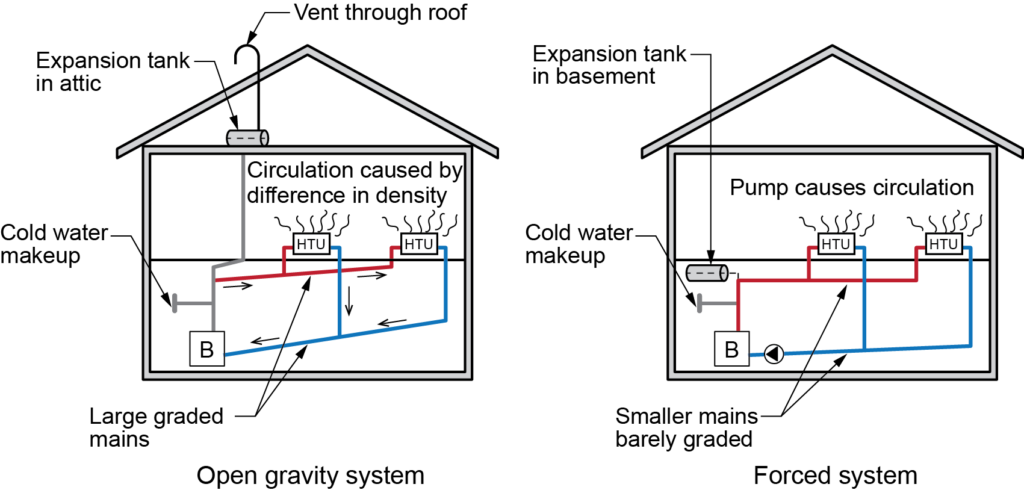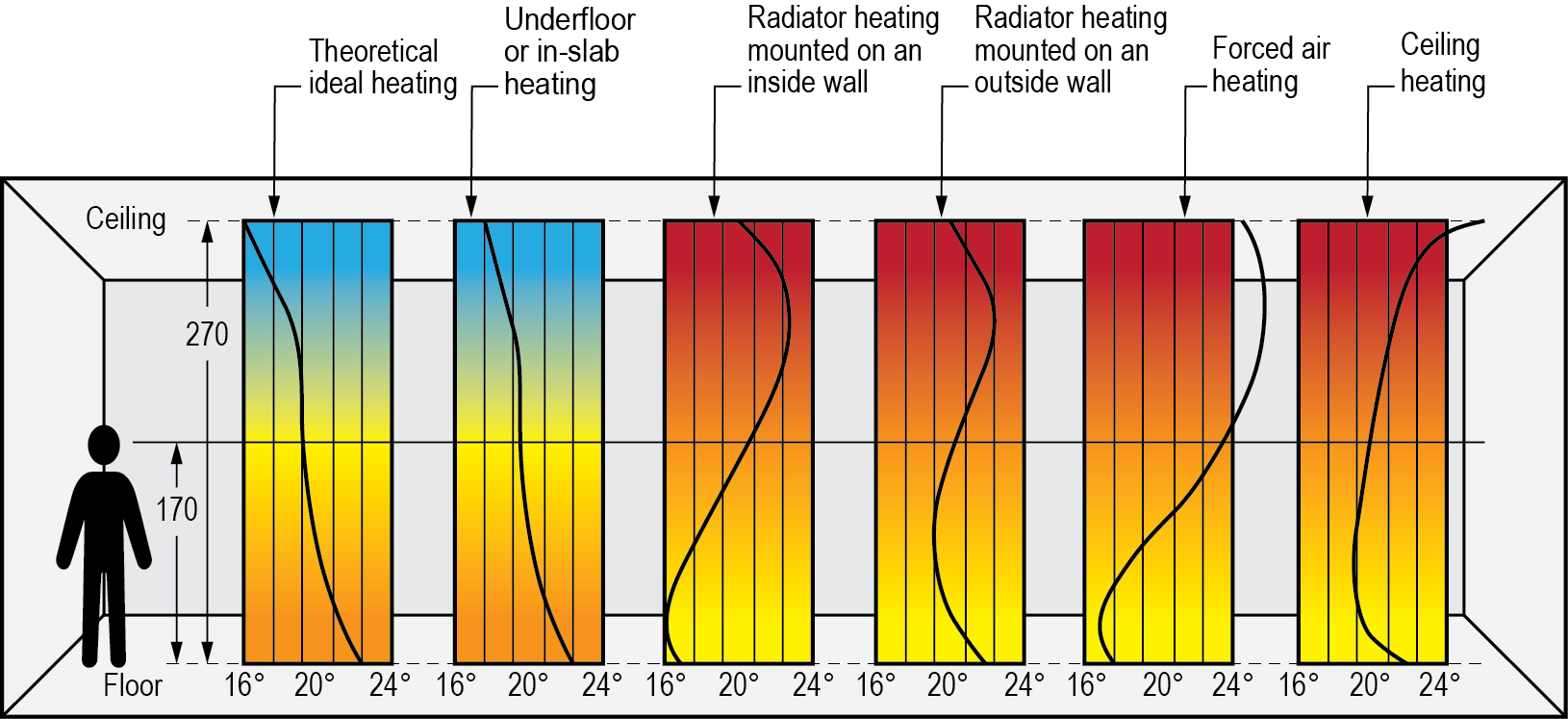B-1.4 Hydronic Heating and Cooling Systems
Hydronics is the concept of using water as a vehicle to move thermal energy between two points. Installers must understand that both hydronic heating and cooling involve the transfer of heat. Heating and cooling systems for buildings either add or remove heat from a space to keep its occupants comfortable. In some cases, heating or cooling is used for process purposes, as with refrigerators, freezers, and kilns.
The study of hydronics here will focus on providing an environment within buildings that allows people to be comfortable during their daily activities. This section will concentrate primarily on using hydronics for heating because this practice is widespread and occurs in both residential and commercial environments, whereas hydronic cooling is not as common in homes and residential buildings.
Hydronic Systems
In hydronic heating systems, water can be thought of as the transportation medium for heat. Thermal energy is absorbed by the water at the heat source (most commonly a boiler), carried by the water through the piping, and released into a space by a heat emitter. Hydronic cooling systems use the same principle, except the water carried by the piping absorbs unwanted heat from a space, such as a room or zone, and takes it back to the equipment that removes the heat (most commonly a cooling tower and chiller). It then sends this chilled water back to the space again. In many of today’s sophisticated building energy systems, the heat absorbed by the chilled water can be used to transfer heat to other parts of the building or to preheat domestic water. This creates greater efficiency within the heating and cooling systems.
Water has many characteristics that make it ideal for heating and cooling. It is nontoxic, non-flammable, and readily available and has one of the highest heat-storage capabilities of any material.
The earliest hydronic heating systems, known as gravity systems, operated on the principle of buoyancy (Figure 1). Water becomes less dense when heated, and this density differential between water in the boiler supply and return mains causes convection currents that carry the hot water out and up through piping to the heat transfer units (HTU). At the HTUs, the water releases its heat and regains density, falling back down through the return piping to the boiler. Because of the absence of electricity and pumps, these systems needed larger diameter piping to create enough circulation to carry heat to the far reaches of a building. With the advent of compact electricity pumps came forced circulation systems to move the water between the heat source and emitters (Figure 1). This resulted in many improvements, such as better control and smaller-diameter piping.

Comfort is the Goal
Comfort can best be described as the absence of discomfort, for example, when a person feels neither too hot nor too cold. It is rare that someone will comment on how comfortable a room feels, but they certainly know when they feel uncomfortable. Maintaining comfort is not a matter of supplying heat to the body but of controlling the manner and rate at which the body loses heat.
Heat is a byproduct of our bodies’ functions, and a normal adult engaged in light activity generates heat at a rate of approximately 400 British thermal units per hour (BTU/h) or 422 kiloJoules per hour (kJ/hr). Comfort is achieved when the interior environment allows heat to leave the body at the same rate as it is produced. As the activity level increases so does the need for the immediate environment to transfer the extra heat away at the same rate that it is being generated. Failing to do so fast enough will cause the person to feel overheated and uncomfortable. When interior conditions allow heat to leave a person’s body at the same rate that it is generated, that person feels comfortable.
In a typical indoor environment, approximately 48% of a person’s body heat is released by thermal radiation to colder surfaces (e.g., standing by a window), 30% is released by convection to surrounding air (e.g., sitting in a drafty room), and 22% is released by evaporation from the skin (sweating). A small amount may also be released by conduction from skin or clothing surfaces in contact with cooler objects (e.g., bare feet on a cold floor and also through respiration (breathing out warm air)). Because the human body is affected mostly by radiant heat loss, people feel the effects of proximity to cold surfaces such as windows and supermarket refrigerators and freezers more easily. The greater the temperature differential (ΔT) between body temperature and ambient or surface temperature, the faster the rate of departing body temperature. Sometimes people notice that they feel cold while standing beside cold surfaces when the ambient temperature is actually at the comfortable level of 22ºC. This is the reason that radiant heating systems are widely accepted as being the most comfortable of all (Figure 2).
The advantage of heating through radiation is that surfaces in rooms tend to become warmer. This reduces the effect of radiant heat loss from the body and increases comfort. Later sections will cover radiant systems in greater detail.

Advantages and Disadvantages of Hydronic Heating and Forced-Air Heating
Water has long been known to be a good heat transportation medium, particularly in Europe, where houses and buildings have been heated by water for decades, even centuries.
The practice of using air for heating is a North American development. Houses here do not tend to stay with one family for generations, as is common in Europe. Many studies have indicated that North Americans stay in one house for an average of seven years and, consequently, the extra cost of a hot water heating system over that of a forced warm air system may not be recovered by the time a person sells their house. Short-term economics are at play here, and comfort is collateral damage.
There are many advantages, and some disadvantages, of heating with hot water rather than with forced air.
Main Advantages
- Energy savings: many studies have consistently shown that hot-water heating systems use less energy than forced-air heating systems in similar structures.
- Control: a hydronic system can have as many areas of control (zones) as the occupants desire. A forced-air system typically has one thermostat location and can only hope to achieve comfort in all areas of a building according to that thermostat’s set point.
- Design flexibility: hydronic heating offers almost unlimited possibilities to accommodate, such as space heating, domestic water heating, snow melting, and pool heating.
- Clean and quiet operation: a hydronic system operating properly is silent, whereas airflow through ducts and outlets generates noise.
- Fewer germs and contaminants: hydronic systems do not circulate as much dust and pollen through the air as forced-air systems. Also, people who are ill can be isolated in bedrooms and their germs are not as readily spread throughout the rest of the building.
- Less air stratification: stratification is the tendency of warm air to rise and accumulate at the ceiling, as shown in Figure 2, while cold air falls and gathers at the floor. The heat losses through the walls near the ceiling are much higher with these “bands” of stratification.
- Non-invasive installation: a [latex]\tfrac{3}{4}[/latex] in. copper tube can carry the same amount of heat energy in water out to a house as can an 8 in. by 14 in. rectangular duct carrying heated air. Piping can be hidden by running through floor joists, whereas heating ducts must be installed below the joists, creating unnecessary drops in ceiling height.
Main Disadvantages
- Installation cost: when comparing the installation costs between of a hydronic heating system and a forced-air system, the forced-air system is on average less costly to install.
- Reaction time: a forced-air system is quicker to respond to temperature demands in a room due to its lower thermal mass than a hydronic system using convectors or radiant panels; of these two, convectors respond more quickly than radiant panels.
- Heat emitter intrusion: aside from radiant floor and ceiling panels, the heat emission units or heat transfer units used in hydronic heating tend to interfere with the aesthetics of a room. Radiators and convectors can affect the placement of furniture and drapes, among other things.
The advantages of hot water heating over forced air are many and contribute toward the general acceptance of hydronic heating as being the system of choice.
 Self-Test B-1.4: Hydronic Heating and Cooling Systems
Self-Test B-1.4: Hydronic Heating and Cooling Systems
Complete Self-Test B-1.4 and check your answers.
If you are using a printed copy, please find Self-Test B-1.4 and Answer Key at the end of this section. If you prefer, you can scan the QR code with your digital device to go directly to the interactive Self-Test.

References
Skilled Trades BC. (2021). Book 1: Fuel gas systems, heating and cooling systems. Plumber apprenticeship program level 2 book 1 (Harmonized). Crown Publications: King’s Printer for British Columbia.
Trades Training BC. (2021). B-1: Describe types of heating and cooling systems. In: Plumber Apprenticeship Program: Level 2. Industry Training Authority, BC.
Media Attributions
All figures are used with permission from Skilled Trades BC (2021) unless otherwise noted.
Steam heating systems use convectors, cast-iron radiators, wall fin tubes, and similar heat-emitting units. (Section B-1.4 and Section B-3.1)

